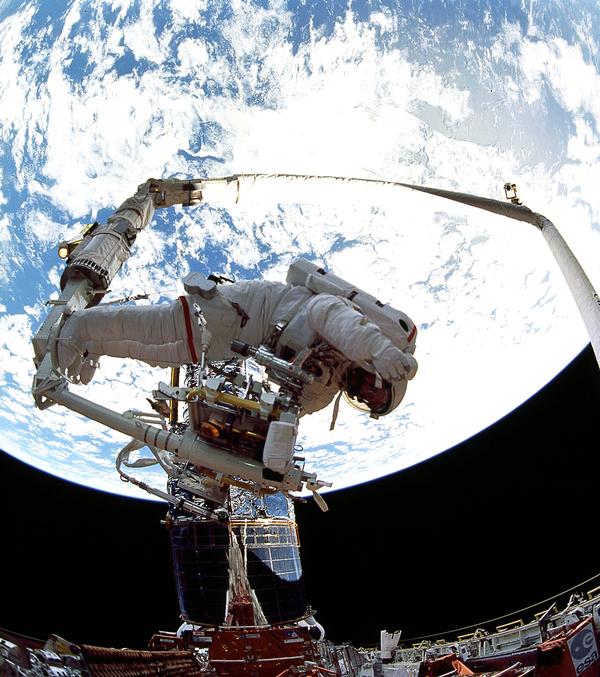
Twenty years ago this week, the singular space shuttle mission which marked the demarcation between past and future took place. Since the resumption of flights in September 1988, following the horrific loss of Challenger, NASA had steadily rebuilt the nation’s confidence in the capabilities of the reusable spacecraft, but the failure of Mars Observer to reach the Red Planet in August 1993 and the much-publicized problems with the Hubble Space Telescope in the aftermath of its 1990 launch left the space agency in an unenviable position. By the middle of the decade, NASA hoped to begin construction of Space Station Freedom—a project whose future still hung under the axe of possible cancellation—and a spectacularly successful Hubble repair mission was acutely needed to reinvigorate public and political enthusiasm. From 2-13 December 1993, that success was accomplished, when the crew of Endeavour on STS-61 broke virtually every record in the book and restored Hubble to its rightful place as the United States’ dazzling icon of science.
It was a mission that every astronaut wanted. In the summer of 1992, Jeff Hoffman was in quarantine, preparing to launch aboard his third shuttle flight, when he fell into conversation with Don Puddy, the head of Flight Crew Operations at the Johnson Space Center (JSC) in Houston, Texas. Puddy was interested in Hoffman’s future plans. Several astronauts had already been approached about their willingness to be considered for flights to the Mir space station, but Hoffman’s height ruled that out. Only one other mission captured his attention. The first Hubble servicing mission stood out like a jewel on the shuttle manifest in December 1993, and as a professional astronomer Hoffman found that it exerted an irresistible pull.
“What I’d really love,” he told Puddy, “is to go on this Hubble mission.”
Puddy laughed. “Oh, yeah. You and the rest of the office!”
Hoffman assumed that his chances of selection were minimal, but in addition to his flight experience he had one other credential which made him an attractive choice for the mission: He was one of few astronauts in the office, at that time, with EVA experience. Several years earlier, in April 1985, Hoffman had participated in the shuttle program’s first contingency spacewalk in a fruitless attempt to activate a deployment switch on the malfunctioning Leasat-3 satellite. With several intricate and complex EVAs scheduled for the Hubble mission, NASA mandated that all members of the four-person spacewalking team must have prior EVA expertise. This obviously disappointed several unflown members of the office, including rookie astronaut Leroy Chiao.
“I was doing EVA training and showing some proficiency at it in the water tank,” Chiao told the NASA oral historian. He had been approached by Dave Leestma, then serving as deputy chief of the office and later to serve as head of Flight Crew Operations, with what Chiao perceived to be a strong hint that he was in line to receive one of the EVA spots on the Hubble mission. “I was very excited about that,” Chiao continued, “and my classmate Eileen Collins … had heard through the grapevine that she was going to get assigned as the pilot on that flight. Then I started hearing rumors that the crew for that flight was going to be changed. They didn’t want any rookies, at least on the EVA team. I have to say that was hard to swallow, because I had worked hard and I had shown proficiency and I had been told I was going to be on that flight and then, for political reasons or visibility reasons, they wanted to be able to say that it was an experienced crew if something had gone wrong.”
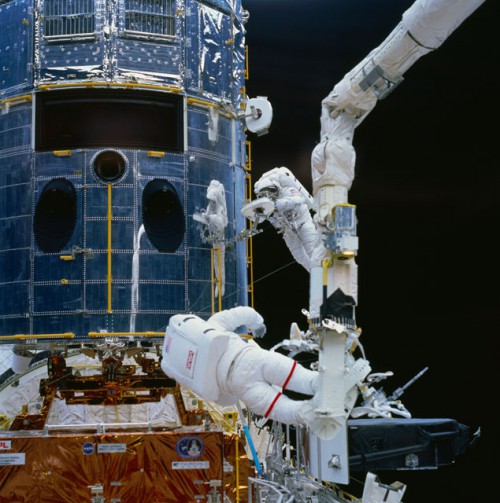
Certainly, in March 1994 Flight International noted that Collins’ name had been proposed, “but was overruled because it was felt that an experienced pilot was needed.” It was not simply a case of NASA being overly cautious. With the loss of Challenger still fresh and the embarrassing failure of Hubble’s ability to resolve distant objects, due to a flaw in its primary optics, the mission to fix the $1.5 billion showpiece telescope was crucial. Congressional support for Space Station Freedom hung on the edge of a knife, and any failure on NASA’s part could spell its cancellation.
Today, Hubble has earned itself a well-deserved reputation as one of the most successful space-based observatories ever launched. Across more than two decades of operations, its instruments have peered deeper into the cosmos than ever before. It has acquired images of distant galaxies, made breakthroughs in physics and cosmology by accurately determining the Universe’s rate of expansion, detected planets around far-off stars, witnessed the impact of a comet into Jupiter, tracked cloud movements in the atmospheres of Uranus and Neptune, and created the best currently achievable “map” of the surface of Pluto.
With the advent of the Space Age, it was hardly surprising that plans for a space-based telescope would become an important step forward and an attractive option for the fields of astronomy and astrophysics. Yet the ideas long pre-dated even the launch of Sputnik. Shortly after the Second World War, physicist Lyman Spitzer of Yale University had argued that an orbiting telescope would offer enormous advantages over ground-based instruments, its abilities unimpaired by the distorting effect of Earth’s atmosphere and its sensors able to detect high-energy emissions, including X-rays, from distant celestial sources. Following the creation of NASA, the first real efforts to develop a space telescope got underway, and in 1975 the agency tried to sell the project to the politicians. Funding was initially denied by the House Appropriations Subcommittee, who reasoned that it was too ambitious, too expensive at around $400 million, and lacked the required support from the National Academy of Sciences. This prompted large-scale lobbying from NASA and leading astronomers and a supportive report from the National Academy of Sciences. International co-operation was directed by Congress and the newly-formed European Space Agency was invited to participate, with its role encompassing the creation of inexpensive solar panels for the telescope. The size of the mirror was reduced from 10 feet (3 meters) to 8 feet (2.4 meters), and together these measures halved the cost from $400 million to $200 million. There were other reasons for the reduction in mirror size. “The Shuttle could not lift a 3-meter telescope to the required orbit,” wrote Andrew Dunar and Stephen Waring in their book Power to Explore. “In addition, changing to a 2.4-meter mirror would lessen fabrication costs by using manufacturing technologies developed for military spy satellites. The smaller mirror would also abbreviate polishing time from 3.5 years to 2.5 years.”
In 1977 Congress granted approval for what was then known as the Large Space Telescope. The primary candidates for the fabrication of the observatory’s mirror were Perkin-Elmer Corporation, whose bid ran to $64.2 million, and Eastman Kodak, teamed with the defence contractor Itek, at almost $99.8 million. Despite being significantly higher, the Kodak-Itek joint bid included two independent tests of the grinding and polishing quality of the finished optics … a “double-checking” provision which Perkin-Elmer did not offer and which would not go unnoticed more than a decade later, when investigators dug into the cause of the telescope’s unfortunate spherical aberration.
Perkin-Elmer received approval from NASA to proceed with their bid in 1979. Meanwhile, Lockheed would build the spacecraft itself and the Europeans would make the solar arrays. In anticipation of the research bonanza, a Space Telescope Science Institute (STScI) was established at the Johns Hopkins University in Maryland in 1983, and the telescope was scheduled for launch by the shuttle in 1985. By this time, it had been named in honor of the American astronomer Edwin P. Hubble, who, in the earlier part of the century, had not only conducted extensive research into the structure of stars and galaxies, but also made the surprising discovery that the Universe was expanding. The mirror was one of the most complex headaches of the project. Optically, Hubble was a Cassegrain reflector and its two hyperbolic mirrors offered good imaging performance across what, for such a large telescope, was a wide field of view … whilst also having shapes which were difficult to fabricate and test. Perkin-Elmer used custom polishing machines to precisely grind the mirror and, in case problems were encountered, NASA required the company to subcontract to Kodak to build a backup mirror using traditional polishing techniques. (The Kodak mirror is today on permanent display in the Smithsonian.)
In 1979, the construction of the Perkin-Elmer mirror began and was completed two years later, washed in hot, deionized water and coated with aluminum and protective magnesium fluoride. NASA remained sceptical about Perkin-Elmer’s ability to competently fabricate the mirror, and the delays ultimately pushed Hubble’s launch back from April 1985 to first the summer and then the fall of 1986. By this time, the total cost of the project had risen to a little more than $1 billion. At the time of its completion, Hubble housed five instruments: the Wide Field Planetary Camera (WFPC, nicknamed “the whiffpick”), the Goddard High Resolution Spectrograph (GHRS), the High Speed Photometer (HSP), the Faint Object Camera (FOC), and the Faint Object Spectrograph (FOS). These devices gave the telescope a range which encompassed not only the visible area of the electromagnetic spectrum, but also the ultraviolet. Physically, Hubble was a cylindrical spacecraft, measuring over 43 feet (13 meters) in length and weighing nearly 24,300 pounds (11,000 kg), which meant that it virtually filled the payload bay. It had been designed to be serviced by future shuttle crews and, as such, was fitted with EVA-friendly hand holds and would be deployed and retrieved using the Remote Manipulator System (RMS) mechanical arm.
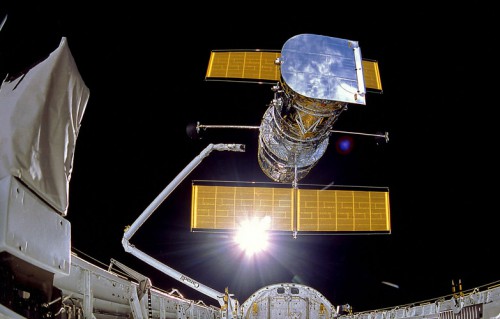
By the time that Challenger was lost, further processing delays had pushed Hubble’s launch back to October 1986. The problems faced by Perkin-Elmer have already been mentioned, but the manufacturer of the telescope’s bodywork, Lockheed, had also suffered difficulties. By the end of 1985, Hubble was over budget by 30 percent and three months behind schedule, bringing it close to breaking the “ceiling” which Congress had imposed on its budget. If Challenger smashed the dreams of so many within America’s space program, it also provided breathing room for payload development. Hubble came through a major thermal vacuum test with flying colors in June 1986, and the enforced down time was used to add more powerful solar arrays, enhance redundancy capabilities, improve the software, install better connectors, and replace the nickel-cadmium batteries that were prone to failure with nickel-hydrogen ones. As a result, by 1990 the Hubble team felt confident that their observatory heralded a new dawn in the study of astronomy.
In the first few weeks after Hubble’s April 1990 launch, the problems seemed reasonably benign: a few communications glitches, drifting star trackers, and snagged coaxial cables were part and parcel in the process of wringing out a new spacecraft. More serious concerns arose when temperature changes bent materials in the solar arrays’ booms, the effect of which was magnified by the orientation mechanism in such a way that it “bounced” the whole telescope. The result was a jittering in Hubble’s images and, since the booms only stabilized in the final few minutes of orbital daylight, the pointing system was only able to meet its design specifications for a fraction of its orbit. Engineers at the Marshall Space Flight Center in Huntsville, Ala., worked with their counterparts at Lockheed to change the control program in the spacecraft’s computer and successfully counteracted the vibrations. On 21 May, Hubble returned its first images of a double star in the constellation of Carina and these were lauded as being much clearer than were achievable with ground-based instruments.
Four weeks later, calamity befell the mission in a manner which could hardly have been anticipated. On 24 June, Hubble failed a focusing test. Its secondary mirror had been adjusted to focus the incoming light from a celestial source, but a fuzzy ring encircled even its best images, creating a blur. Additional tests revealed that the telescope was suffering from a “spherical aberration” in its primary mirror; in essence, Perkin-Elmer had ground it to the wrong specification, removing too much glass and polishing it too flat … by a mere fiftieth of the width of a human hair. The consequence was that Hubble was unable to acquire sharp images. With mounting horror, NASA realized that its attempts to sell its scientific showpiece on the basis of its ability to see further into the cosmos than ever before, with unprecedented clarity, now became very hollow indeed. The promised white knight of astronomy was now a white elephant. Even Hubble’s chief scientist, Ed Weiler, admitted that it was comparable only to “a very good ground telescope on a very good night.” Marshall staff were astounded and Senator Barbara Mikulski of Maryland exploded that Hubble wasted taxpayers’ money and was little more than “a techno-turkey.” Meanwhile, Senator Al Gore—then a Democrat for Tennessee and later vice president during the Clinton Administration—observed that, for the second time in less than half a decade, quality control shortcomings at NASA had been publicly exposed. The media had a field day. On 28 July 1990, the New York Times noted that, had Kodak-Itek’s bid been accepted, then the mirror would have been subjected to two independent checks of its grinding and polishing accuracy, which certainly would have caught the error and enabled it to be rectified before launch.
NASA responded to critics by asserting that, with 20-20 hindsight, it would have cost in excess of $100 million to incorporate additional testing and independent checking of the telescope optics into Perkin-Elmer’s contract, but the effect on the general public was the same. The once-proud agency was rendered a laughing-stock on late-night TV talk shows. David Letterman compiled a pejorative list of Top Ten Hubble Excuses, whilst others criticized the Marshall Space Flight Center for having been in charge of both the Hubble development and the shuttle’s Solid Rocket Boosters (SRBs). Several analysts noted that NASA’s attitude had changed from the 1960s, in which problems were anticipated and incorporated into planning, into one where there was apparently little effort to prepare for unforeseen obstacles.
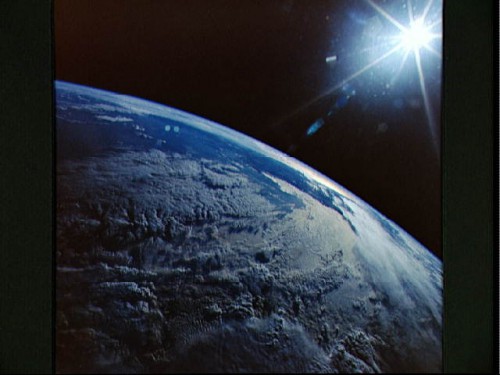
In early July 1990, NASA established an investigating committee, chaired by Lew Allen, head of the Jet Propulsion Laboratory. His report, published in November, harshly criticised the incorrect assembly of the “reflective null corrector,” an optical device used to determine the figure of Hubble’s mirror. The location of a lens in the device was improperly measured, and the null corrector guided the polisher to shape a perfectly smooth mirror … with the wrong curvature. Analysis revealed that the curvature flaw in the primary mirror exactly matched the flaw in the null corrector. A second null corrector, made only with lenses, was also built to measure the vertex radius of the finished mirror. It, too, identified an error in the primary mirror. However, neither of these warning signs were heeded and Allen’s report noted that “both indicators of error were discounted at the time as being themselves flawed.” During the fabrication process, technicians had simply assumed the perfection of the mirror and of the reflective null corrector and therefore had rejected information from other independent tests, having convinced themselves that no problems existed. These errors were ultimately traced back to 1981-82, when Perkin-Elmer and the Marshall Space Flight Center had been distracted by serious cost and schedule difficulties. Allen’s report was particularly critical of Perkin-Elmer quality control and communications failures, as well as the failure of Marshall to correct them.
In orbit, the spherical aberration was particularly obvious in its effect on Hubble’s WFPC and FOC, both of which suffered in terms of spatial resolution and their ability to acquire images of individual celestial objects, including planets, star clusters, and galaxies. Having said this, the aberration was well characterized and stable, and, over time, astronomers were able to optimize the results obtained from Hubble by using sophisticated techniques, such as “deconvolution,” whereby software algorithms and microwave image processing was employed to remove many of the blurring effects of optical distortion. However, the results were still less than ideal. Spectroscopy by the FOS and GHRS instruments was less severely affected, because the instruments required less focused light, and by increasing exposure times it became possible to gather valuable images. Nevertheless, by the end of 1991 Hubble had made almost 2,000 quality observations of hundreds of astronomical objects, including storms on Saturn and images of Pluto’s moon, Charon. At the start of the following year, a quarter of all the papers presented before the American Astronomical Society’s meeting drew on Hubble data. A repair was critical in order to restore the telescope to its pre-flight billing, although NASA announced in July 1991 that it was “not planning an early visit” to repair the telescope, preferring instead to stick with the previous schedule of an all-up servicing mission in late 1993. Even though Kodak-Itek had produced their mirror, this could not simply be inserted into the spacecraft, so the solution would have to overcome the problem with the existing primary mirror. A new device—the $50 million Corrective Optics Space Telescope Axial Replacement (COSTAR)—would need to be developed and manifested onto the first servicing mission to revitalise its vision. In October 1991, NASA awarded a $30.4 million contract to Ball Aerospace to fabricate COSTAR, whose 10 small, coin-sized mirrors were expected to correct the spherical aberration and restore the potential of the affected instruments.
Interestingly, Bruce McCandless, one of the astronauts who carried Hubble into orbit on STS-31 in April 1990, was closely involved with the development of the optics, as related by his former crewmate Kathy Sullivan. She remembered McCandless telling her that all ideas of how to restore its capabilities were entertained, even the wildest and most outlandish ones, such as directly entering Hubble’s telescope barrel. “The bad news is you did indeed screw up the mirror by an amount that is significant and should be avoidable in figuring astronomical mirrors,” Sullivan told the NASA oral historian. “The good news is you screwed it up very precisely! This meant you knew the actual mirror shape, very precisely, and could do a precise difference calculation of the actual versus the desired and determine the needed correction out of that.” This realization was met with a determination that the correction could be accomplished through reflective lenses, instead of transmissive ones, and was intricate in its scope and brilliantly clever. As Sullivan put it: “I don’t have to make all that light come through a lens. I can bounce it off several mirrors and through a couple of steps basically restore it to the focus that it should have had.”
COSTAR’s mandate was to optically correct the effects of spherical aberration upon the instruments … at the expense of losing the phonebooth-sized High Speed Photometer, which had been rendered virtually useless by the solar array jitters. COSTAR was invented by the Hubble Space Telescope Strategy Panel, a group of scientists and engineers convened by the STScI in late 1990, and, after the removal of the HSP, would be installed in its stead. “Once in place,” explained NASA’s pre-mission press kit, “COSTAR will deploy a set of mechanical arms, no longer than a human hand, that will place corrective mirrors in front of the openings that admit light” into the affected instruments. In doing so, it would refocus light from Hubble’s primary mirror before it reached those instruments and was expected to bring their overall optical performance “very close” to original specifications. Subsequent instruments for the telescope would be specifically designed with their own corrective optics. Dr. John Wood of NASA’s Goddard Space Flight Center in Greenbelt, Md., was placed in charge of the COSTAR development effort. Its installation and that of a new whiffpick (WFPC-2) would come atop an already hefty pile of work for the First Servicing Mission (SM-1), which already involved the replacement of Hubble’s twin solar arrays and drive electronics, two of the three Rate Sensing Units, one of two Electronic Control Units, one of two magnetometers, and fuse plugs to correct wiring and sizing discrepancies.
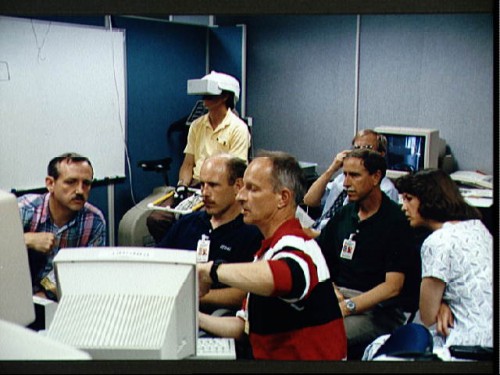
“Whoever was going to be doing something on the Hubble mission had to have done it before,” recalled Jeff Hoffman in his NASA oral history. “You had to have somebody who had already been a commander, somebody who had already been a pilot, four people who had already done EVAs and somebody who had already done a significant arm operation.” In March 1992, Story Musgrave was assigned as payload commander for the flight, designated STS-61, and in August Hoffman and fellow astronauts Kathy Thornton and Tom Akers joined him to support at least five ambitious EVAs. The mission thus morphed into something which would represent nothing less than an opportunity for NASA to prove itself triumphantly … or fail spectacularly.
In its January 1990 manifest, the agency listed SM-1 as a five-day flight with a crew of five, suggesting a maximum of only two or three EVAs, but as 1991 wore into 1992 and onward into 1993 it became increasingly clear that the mission would run to as long as 11 days and evaluations of underwater simulations convinced managers that they should schedule as many as five back-to-back EVAs over five days. According to Mission Director Randy Brinkley, the decision served to “repackage our margin” and offered the chance to “respond to the dynamics, or unknowns, of spacewalks.” (The flight plan actually provided for a sixth and seventh EVA, and a mission duration of up to 13 days, although ultimately this did not become necessary.)
Such an enormous workload demanded a crew of seven, with two alternating teams of spacewalkers, to reduce fatigue and enhance the likelihood of mission success. Original plans called for all tools to be kept outside, in the shuttle’s payload bay, but the crew recognized at an early stage that EVA time was a critical limiting consumable and decided that the hour spent preparing equipment at the start of each excursion could be better spent starting the repair work. It was therefore decided that some tools would be kept inside Endeavour’s crew cabin, enabling the spacewalkers to load-up before opening the airlock and utilising their suits’ consumables. “What we’ve done by going to five EVAs, rather than three, is to repackage our margin,” said STS-61 Mission Director Randy Brinkley, “so that we have the capability to respond to the dynamics, or unknowns, of spacewalks. It improves the probabilities for mission success, while providing added flexibility and adaptability for reacting to real-time situations.”
In December 1992, Dick Covey, Ken Bowersox, and Swiss astronaut Claude Nicollier were named, respectively, as commander, pilot, and operator of the RMS arm, which would pluck Hubble out of orbit, anchor it into the payload bay for repairs, and subsequently deploy it back into space to begin its reinvigorated studies of the Universe. According to Tim Furniss, writing in Flight International in March 1994, Nicollier was specifically requested by NASA Administrator Dan Goldin for the RMS task, “to reflect the European involvement in the Hubble programme.” Having received such a plum assignment, the STS-61 team bore the brunt of much good-natured ribbing from their fellow astronauts. On one occasion, Thornton quipped to her crewmates: “Well, guys, everybody is gonna hate us now!”
Covey’s arrival on the crew was particularly interesting; in Flight International, Tim Furniss noted that he had been “strangely sidelined” since his last mission, STS-38. Covey had flown the Leasat-3 retrieval and repair mission in August 1985 and thus was well-versed in the rendezvous, proximity operations, and servicing associated with a large payload, but his previous stints as acting chief of the astronaut office and acting head of Flight Crew Operations certainly also factored into his selection. Late in 1992, he was called to a meeting by JSC Director Aaron Cohen and his deputy, Paul Weitz, and offered a choice: He could either be the permanent chief of the astronaut office or he could command the Hubble flight. By his own admission, it took Covey “about two seconds” to make his choice.
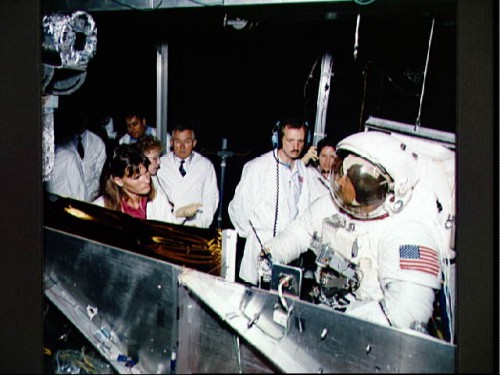
“Doing five [EVAs] really pushed the bounds of what people thought we could do,” Covey recalled in his oral history. “Even with four EVA crew members, even with an 11-day mission, it just started pushing the bounds. There was a lot of scrutiny on it and a lot of focus on it.” The size of their quarry posed additional problems. Hubble was far larger than anything with which the shuttle had previously rendezvoused in orbit, and Claude Nicollier was faced with the unenviable challenge of manoeuvring his EVA crewmates, along with phonebooth-sized pieces of hardware, into position with extreme delicacy and precision. “The integrated operations,” said Covey, “of Shuttle maneuvering, RMS activities and EVAs, although now commonplace, wasn’t back then. So integrating all of those activities and the crew activities together was a big part of my role as the commander.”
To be fair, the audacity of the mission filled NASA’s top brass with dread and the memory of Challenger still loomed large in many minds. In May 1993, the Task Force on the Hubble Space Telescope Servicing Mission, established by NASA Administrator Dan Goldin the previous January and chaired by Dr Joe Shea, concluded that “the mission is achievable.” This was primarily due to the fact that Hubble and most of its subsystems were originally designed for orbital maintenance. However, Shea’s report noted that such missions were enormously complex in their scope and required more EVA time than had been achieved on any flight up to that time.
With this stark reality in mind, the group advised that planning for the next Hubble servicing should enter the planning stage within 6-12 months of STS-61, in order to “handle tasks that might not be completed during the first mission or respond to failures that occur in the intervening months.” Shea also found that the appointment of a Mission Director (Brinkley) was “necessary if the mission is to be carried out with confidence.” However, the August 1993 loss of Mars Observer, only days before it was due to enter orbit around the Red Planet, added to the popular sense of NASA as an organisation of failure. An article in Aviation Week hinted that WFPC-2 might also be flawed, and it so unnerved the Clinton Administration that Goldin was invited to attend an audience with the president to discuss the agency’s level of preparedness for SM-1. It has been suggested that Clinton told Goldin that the agency had either to make the Hubble repair mission work or be drastically restructured. Mistakes could not be tolerated.
The heat was on the agency, on the STS-61 crew, and on the thousands of engineers and technicians responsible for ensuring that COSTAR and WFPC-2 were ready for launch in December 1993. Nerves frequently became frayed in the final months. Late in September, NASA announced that “further testing” of WFPC-2 “might be necessary,” requiring it to be shipped back from the Kennedy Space Center to the Goddard Space Flight Center, although such a move was not expected to affect the scheduled launch in early December. According to Joseph Rothenberg, Associate Director of Flight Projects for Hubble Space Telescope at Goddard, results from earlier tests suggested that the focus point for HST might be outside the COSTAR adjustment range and that focusing both it and WFPC-2, simultaneously, might not be achievable. As circumstances transpired, such a move was unnecessary, but time constraints were critical.
Are we missing something? was the introspective question often asked of themselves and each other. Others were irritated by constant claims that they were “testing things to death” and therein causing further delays, which prompted one manager to explode: “We wouldn’t be here if you guys had tested this thing to death the first time!” Some engineers jokingly offered to spend the New Year in Acapulco, figuring that if SM-1 succeeded they might be able to return home to the United States, and if it failed they would be forced to wait on restaurant tables in Mexico for the rest of their lives!
The second part of this article will appear tomorrow.
Want to keep up-to-date with all things space? Be sure to “Like” AmericaSpace on Facebook and follow us on Twitter: @AmericaSpace



